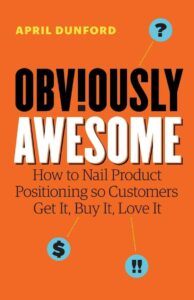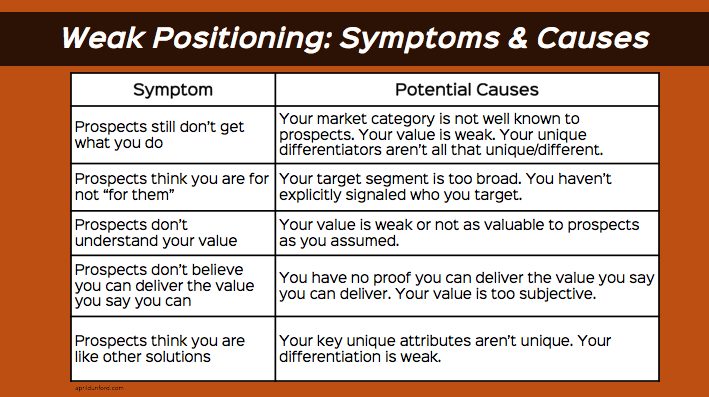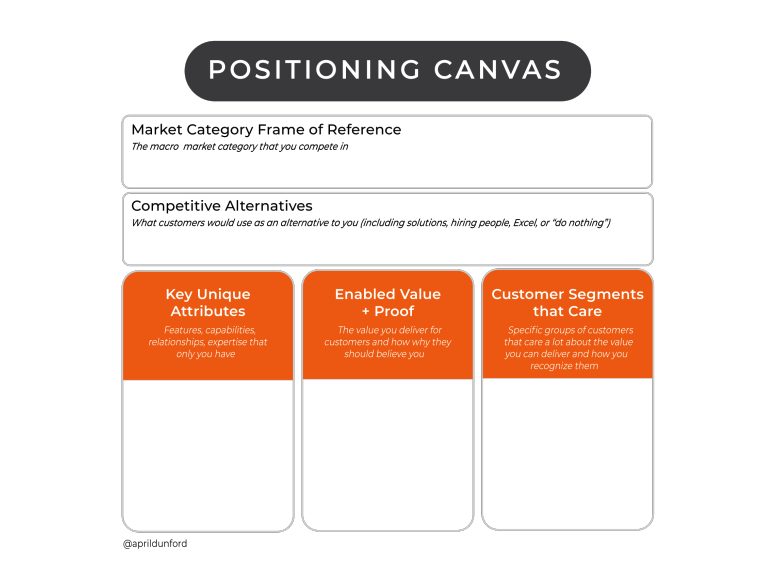Book Summary:
Obviously Awesome by April Dunford
Obviously Awesome by April Dunford

🛍️ Buy this book on Amazon (Audible, Kindle, or paperback): https://amzn.to/3wQUx4u
😋 Thanks! By buying books through my affiliate link, you’re supporting my work (and my next surfing trip).
🗒 Note: My notes are a mix of key ideas and quotes from the book as well as my own thoughts.
- Positioning is the foundation of every ad, sales pitch, and piece of content we create.
- It is the key to the success of the business itself.
- It gives our customers a reference point regarding our product.
- It helps them understand to which category it belongs and what parameters they should consider when evaluating it.
- Most products are exceptional only when we understand them within their best frame of reference.
👉 Define yourself, or others will define you.
How to know that you have a positioning problem:
— Your current customers love you, but you’re struggling to sell to new prospects.
— Customers often leave or ask for new features. They misunderstood what you’re doing, and now they want to recover the money they paid.
— You have long sales cycles and low close rates.
— People do not understand your real value, so they’re not satisfied with the price.
— Prospects and customers describe your business differently than how you see it.
Common positioning mistakes:
— Thinking that there’s only one way to position your product. There are always plenty of ways you can look at it.
— You’re stuck on the idea of what you were planning your product to be without noticing what it has become in reality.
— Market confusion: when we as product creators understand the product differently from how customers perceive it.
— You created your product for a specific market, but while you were busy working, the market has changed. Most products can solve many different problems. Many products had been sold for one purpose, but when the market shifted, their purpose (and positioning) changed as well.
— Ask yourself: is the history of my product and the way I describe it exist in my marketing today? If yes, ask yourself what has changed since then. Maybe those things aren’t relevant anymore.
🧁 For example, baking soda was first marketed as a product for… baking. But when sales declined because baking wasn’t as popular anymore, Arm & Hammer started promoting baking soda for its ability to absorb bad odors. This repositioning helped them grow their sales. When the founders freed their minds from the old beliefs they had about the product, they could grow more.

Main topics that positioning covers:
1. What we do
2. Why we are special
3. Which customers can we best serve
4. The market we intend to win
The key components of positioning:
- Competitive solutions: if you didn’t exist, what would customers use? (use XLS or Google Docs instead; might as well be “do nothing and suffer”)
- Unique attributes: what features/capabilities do you have that alternatives do not?
- Value and proof: what value do the attributes enable for customers? What proof of that value do you have? (only testimonials and expert opinions count as proof of value)
- Target market characteristic: who cares a lot about that value?
- Market category: what market do you describe yourself as being part of? (your market category is the context that makes your value obvious to these target customers)
- Trends: what trends make your product relevant right now? These should be trends that your audience is interested in. They can help make your product more relevant and attractive. (e.g., NFTs, Pantone color of the year, sharing economy, etc.)
- To identify your main audience, ask yourself if I had to make as many sales as possible TODAY, who would you go to first? What are their problems? Example: A bank with a big database that needs to analyze quickly.
- The market category you chose always comes with a list of assumptions and stigmas. Pick the wrong category, and you’ll spend lots of time and money breaking those stigmas. On the other hand, the right category can save you plenty of money and explanations.
The 10-step positioning framework
1. Understand your best customers. Why do they like your product so much? What are their problems? And where can you find more people like them? (Note: This positioning process works only for companies that already have some sort of an audience/customer base).
2. Form a positioning team. Invite someone from each department – management, marketing, sales, customer success, and product – to have diverse input.
3. Align your positioning vocabulary and let go of your positioning baggage. First, go over the different steps of positioning with your team and see that everyone understands the process and the positioning terms. Then, agree to put your current views on position aside to be able to come up with new ideas.
4. List your competitors and alternatives.
5. List all your attributes and feature.
6. Benefits and value. Turn the most important features into benefits, and understand what is their real value to your target audience.
Examples:
Features (50-megapixel camera)
Benefits (sharper images)
Value (putting the benefit into the context the customer is trying to achieve — photos that are sharp even when printed or zoomed in.)
🧁 I’d even go further and say that when speaking about product value, we must show how the benefit helps the customer in a specific situation in their life.
Example: “Remember every detail of your family vacation.”
Remember: You don’t have the privilege of letting the customers figure out the value by themselves. You should tell them.
7. Determine who cares a lot (segmentation). Go back to the people. Target your audience as narrowly as possible. It’s easier to sell to and retain a best-fit customer. Your biggest fans.
— Here, instead of just using demographics, try to find unique and specific characteristics like the person’s job, favorite brands, entertainment channels, music, etc, — Also, your prospect doesn’t have to be a person; it can also be a company. In that case, you can determine the way they sell, other products they invested in, and skills they have or don’t have inside the company.
🎯 Two criteria that make a target audience relevant:
- It’s big enough (enough people or businesses under that category) so that it’s possible to meet your business goals.
- It needs to have important specific unmet needs that are common to the segment.
For example, if you produce tennis rackets for seniors, make sure that there are enough seniors who play tennis, and second, that you can fulfill an unmet need that seniors have in their rackets. For instance, the regular rackets are too heavy.
8. Find a market frame or reference that puts your strengths at the center. Learn how to position yourself in it:
— Picking a market is like giving customers an answer to the question: “what are you?”
— We can choose to enter an existing market or create a new one. If we enter an existing one, we can either try to lead it or take over a slice of it.
🧘♂️ Here are some positioning strategies:
a. Head to head; beat the leader at their own game. If you’re aiming to win in a market that already exists, you need to beat the established leader. This one is better if you’re a big company entering a new market. Especially when the market is shifting in a way that can put the leader at a disadvantage.
For example, new technologies, regulations, or trends; the market exists or emerging quickly, but there’s no real leader, like in the smart glasses market.
🏆 The benefit of joining an existing category is that you don’t have to teach customers about the category.
b. Big fish, small pond. If you’re trying to win a sub-segment in an existing market, your goal is not to take over the leaders. Instead, you need to target clients in your sub-segment who have requirements that are not being met by the current products.
Test: How to figure out if you have enough potential customers in your sub-segment? Calculate how many sales you’d have to make to hit your goals this year. If the number is, say, 30, and you have only a hundred businesses or customers in your segment, you’re in trouble.
For example, find an easy way to identify the people or businesses in that segment (company size, occupation, location, etc.).
🐡 Use this strategy when the market is well defined, understood, and there’s a clear leader. You’ll need a sub-segment with clear needs that are not met by the main leader.
c. Create a new category (a.k.a. create a new game). First, you need to prove to the customers that a new category needs to exist. Second, you need to define the parameters of that market in the mind of customers. And lastly, position yourself as the leader within it.
Note: This position style takes a lot of teaching about the category and why you’re the best in it. You need a demonstrably and unarguably new product to use this method.
🆕 It can be hard, but in this category, you can define the purchase criteria to perfectly fit your product. Many startups fail here because they’re not patient enough. They do all the heavy lifting to establish the category but then give up or get beaten by another competitor who takes advantage of their hard work.
9. Use a trend. But only if it has a real, relevant connection to the product.
10. Capture your positioning so that you can share it internally.
The author recommends positioning using her canvas:

How to implement your new positioning:
- Even before you create any ads, come up with a sales story; define what a presentation of a sales team will look like.
- Start with the current solutions.
- Then show what should happen in a perfect world, where the current solutions don’t provide.
- Then show your solution.
- And finally, present the value your features provide and the proof-of-value (testimonials, a case study, and answers to common objections).
- Positioning needs to be updated once in a while:
- Outside forces like new competitors, existing regulations, and new technologies can force you to adjust your positioning.
For example, if you’re a regular airline company, but then a new low-cost competitor enters the market, you may have to position yourself as a premium airline or drop your prices.
- Outside forces like new competitors, existing regulations, and new technologies can force you to adjust your positioning.
- Summary
— Any product can be positioned in multiple markets. Your product doesn’t have to be stuck in a market where no one understands how awesome it is.
— Great positioning rarely comes by default. You have to do it intentionally if you want to succeed.
— Understanding what your customers see as the alternative to your solution will lead you to your differentiators.
— Position yourself in a market that makes your strengths obvious.
— Use trends to make your product more interesting right now. Don’t lay on a trend just for the sake of it. It has to make sense.
Learn how to write copy that sticks
Hey, it’s Shlomo. Thanks for reading my book summary 🙂
I’m building the world’s largest collection of techniques and tools for copywriters,marketers, and other creative creatures.
Currently, the website includes:
💡35+ step-by-step guides
🛠 150+ online tools
❤️ All for free